Ultraviolet Background Radiation from Not-So-Dark Matter in the Galactic Halo
Abstract
1. Introduction
2. Observations
3. Galactic Halo
4. Not-So-Dark Matter
5. Conclusions
Author Contributions
Funding
Data Availability Statement
Conflicts of Interest
References
- Henry, R.C. Diffuse background radiation. Astrophys. J. 1999, 516, L49–L52. [Google Scholar] [CrossRef][Green Version]
- Bowyer, S. The cosmic far ultraviolet background. Ann. Rev. Astron. Astrophys. 1991, 59, 59–88. [Google Scholar] [CrossRef]
- Henry, R.C. Ultraviolet background radiation. Ann. Rev. Astron. Astrophys. 1991, 59, 89–127. [Google Scholar] [CrossRef]
- Martin, C.; Bowyer, S. Discovery of high-ionization far-ultraviolet line emission from the interstellar medium. Astrophys. J. 1990, 350, 242–261. [Google Scholar] [CrossRef]
- Martin, C.; Hurwitz, M.; Bowyer, S. Discovery of molecular hydrogen fluorescence in the diffuse interstellar medium. Astrophys. J. 1990, 354, 220–228. [Google Scholar] [CrossRef]
- Kulkarni, S.R. The far ultra-violet background. Proc. Astron. Soc. Pac. 2022, 134, 084302. [Google Scholar] [CrossRef]
- Henry, R.C. The local interstellar ultraviolet radiation field. Astrophys. J. 2002, 570, 697–707. [Google Scholar] [CrossRef]
- Henry, R.C.; Murthy, J.; Overduin, J.M.; Tyler, J. The mystery of the cosmic diffuse ultraviolet background radiation. Astrophys. J. 2015, 798, 14–39. [Google Scholar] [CrossRef]
- Murthy, J. GALEX diffuse observations of the sky: The data. Astrophys. J. Supp. Ser. 2014, 213, 32. [Google Scholar] [CrossRef]
- Stern, S.A.; Slater, D.C.; Scherrer, J.; Stone, J.; Dirks, G.; Versteeg, M.; Davis, M.; Gladstone, G.R.; Parker, J.W.; Young, L.A.; et al. ALICE: The ultraviolet imaging spectrograph aboard the New Horizons Pluto–Kuiper Belt Mission. Sp. Sci. Rev. 2008, 140, 155–187. [Google Scholar] [CrossRef]
- Murthy, J.; Shull, J.M.; Postman, M.; Parker, J.W.; Redfield, S.; Cunningham, N.; Gladstone, G.R.; Pineau, J.P.; Brandt, P.; Verbiscer, A.J.; et al. Excess ultraviolet emission at high galactic latitudes: A New Horizons view. Astron. J. 2025, 169, 103. [Google Scholar]
- Weaver, H.A.; Cheng, A.F.; Morgan, F.; Taylor, H.W.; Conard, S.J.; Nunez, J.I.; Rodgers, D.J.; Lauer, T.R.; Owen, W.M.; Spencer, J.R.; et al. In-flight performance and calibration of the LOng-Range Reconnaissance Imager (LORRI) for the New Horizons Mission. Pub. Astron. Soc. Pac. 2020, 132, 035003. [Google Scholar] [CrossRef]
- Symons, T.; Zemcov, M.; Cooray, A.; Lisse, C.; Poppe, A.R. A Measurement of the cosmic optical background and diffuse galactic light scaling from the R<50 AU New Horizons-LORRI data. Astrophys. J. 2023, 945, 45. [Google Scholar]
- Postman, M.; Lauer, T.R.; Parker, J.W.; Spencer, J.R.; Weaver, H.A.; Shull, J.M.; Stern, S.A.; Brandt, P.; Conard, S.J.; Gladstone, G.R.; et al. New synoptic Observations of the Cosmic Optical Background with New Horizons. Astrophys. J. 2024, 972, 95. [Google Scholar] [CrossRef]
- Chiang, Y.-K.; Ménard, B.; Schiminovich, D. Broadband intensity tomography: Spectral tagging of the cosmic UV background. Astrophys. J. 2019, 877, 150. [Google Scholar] [CrossRef]
- Welch, B.; McCandliss, S.; Coe, D. Galaxy cluster contribution to the diffuse extragalactic ultraviolet background. Astron. J. 2020, 159, 269. [Google Scholar] [CrossRef]
- Feltz, K.A., Jr. Interstellar reddening near the north galactic pole. Pub. Astron. Soc. Pac. 1972, 84, 472. [Google Scholar] [CrossRef]
- Sciama, D.W. Dark matter decay and the ionization of HI regions in the Galaxy. Astrophys. J. 1990, 364, 549. [Google Scholar] [CrossRef]
- Melott, A.L.; McKay, D.W.; Ralston, J.P. Has dark matter decay been detected? Astrophys. J. Lett. 1988, 324, L43–L46. [Google Scholar] [CrossRef]
- Davidsen, A.F.; Kriss, G.A.; Ferguson, H.C.; Blair, W.P.; Bowers, C.W.; Dixon, W.V.; Durrance, S.T.; Feldman, P.D.; Henry, R.C.; Kimble, R.A.; et al. Test of the decaying dark matter hypothesis using the Hopkins Ultraviolet Telescope. Nature 1991, 351, 128–130. [Google Scholar] [CrossRef]
- Spitzer, L.; Greenstein, J. Continuous emission from planetary nebulae. Astrophys. J. 1951, 114, 407. [Google Scholar] [CrossRef]
- Akshaya, M.S.; Murthy, J.; Ravichandran, S.; Henry, R.C.; Overduin, J.M. The diffuse radiation field at high Galactic latitudes. Astrophys. J. 2018, 858, 101. [Google Scholar] [CrossRef]
- Zhitnitsky, A. The mysterious diffuse UV radiation and axion quark nugget dark matter model. Phys. Lett. B 2022, 828, 137015. [Google Scholar] [CrossRef]
- Majidi, F.; Liang, X.; Van Waerbeke, L.; Zhitnitsky, A.; Sekatchev, M.; Sommer, J.S.; Dolag, K.; Castro, T. The glow of axion quark nugget dark matter. Part I. Large scale structures. J. Cosmol. Astropart. Phys. 2024, 2024, 045. [Google Scholar] [CrossRef]
- Sommer, J.S.; Dolag, K.; Böss, L.M.; Khabibullin, I.; Liang, X.; Van Waerbeke, L.; Zhitnitsky, A.; Majidi, F.; Sorce, J.G.; Seidel, B.; et al. The glow of axion quark nugget dark matter. II. Galaxy clusters. Astron. Astrophys. 2024, 691, A38. [Google Scholar] [CrossRef]
- Sekatchev, M.; Liang, X.; Majidi, F.; Scully, B.; Waerbeke, L.V.; Zhitnitsky, A. The glow of axion quark nugget dark matter: III. The mysteries of the Milky Way UV background. J. Cosmol. Astropart. Phys. 2025; submitted. [Google Scholar]
- Atek, H.; Labbé, I.; Furtak, L.J.; Chemerynska, I.; Fujimoto, S.; Setton, D.J.; Miller, T.B.; Oesch, P.; Bezanson, R.; Price, S.H.; et al. Most of the photons that reionized the Universe came from dwarf galaxies. Nature 2024, 626, 975–978. [Google Scholar] [CrossRef]

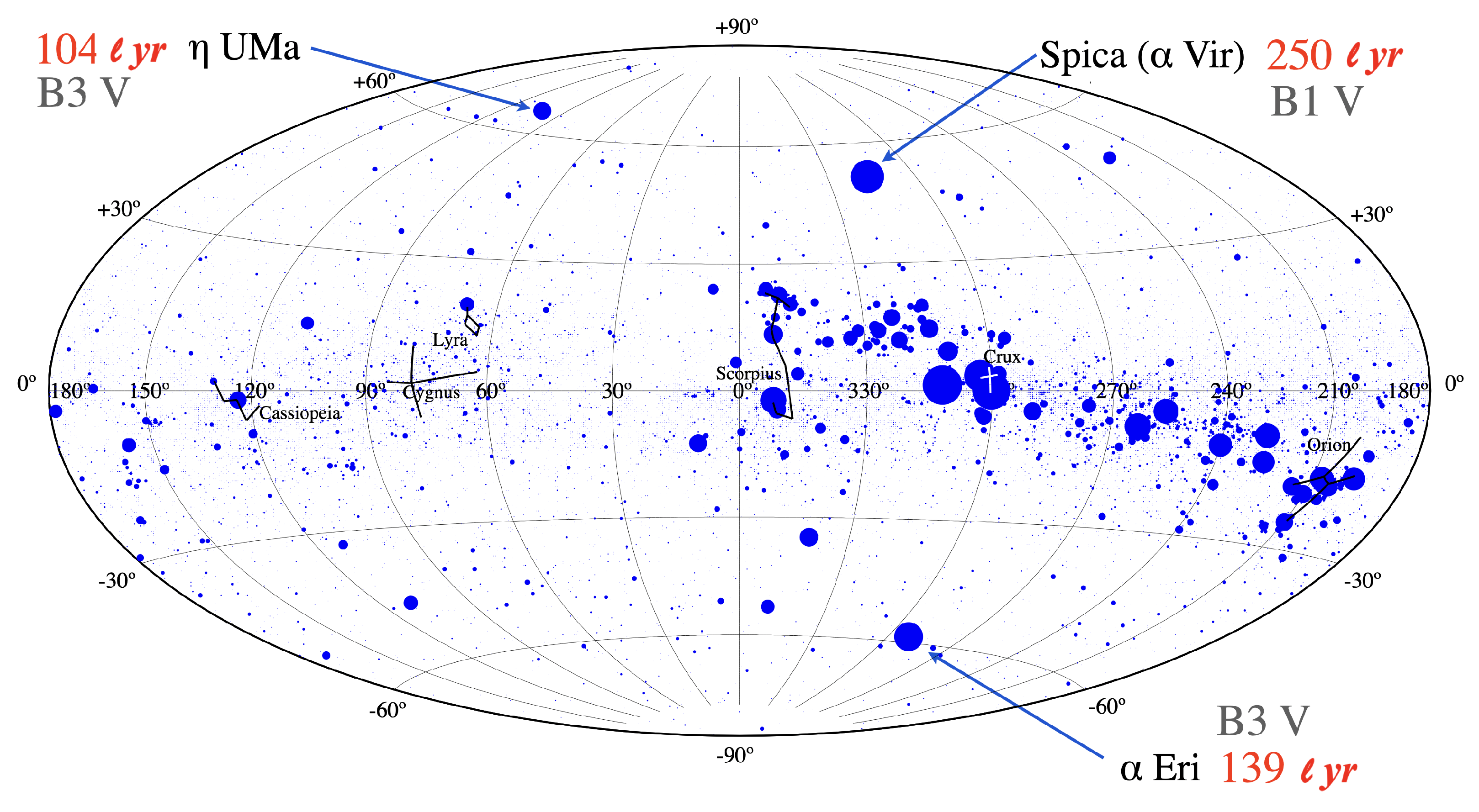
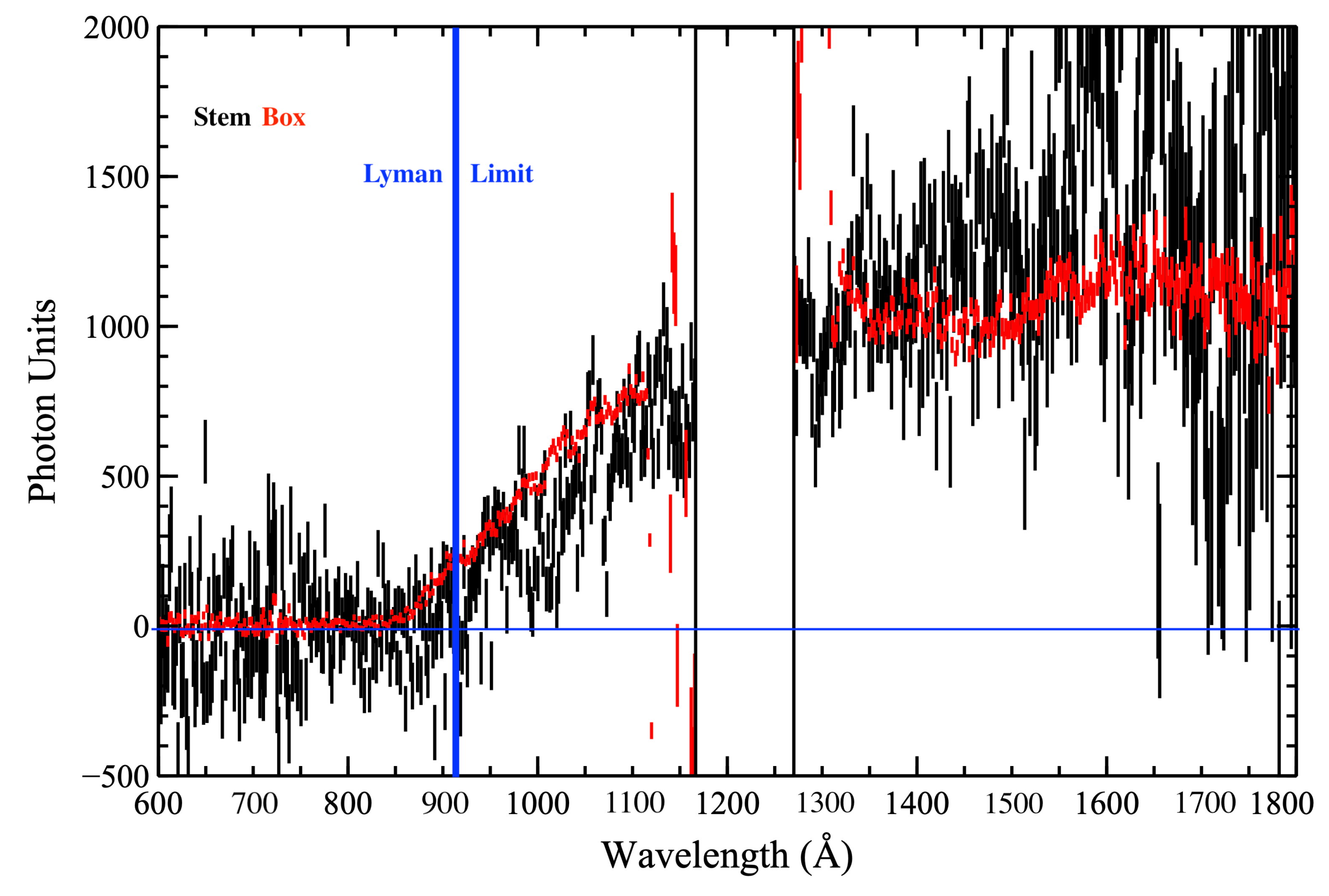
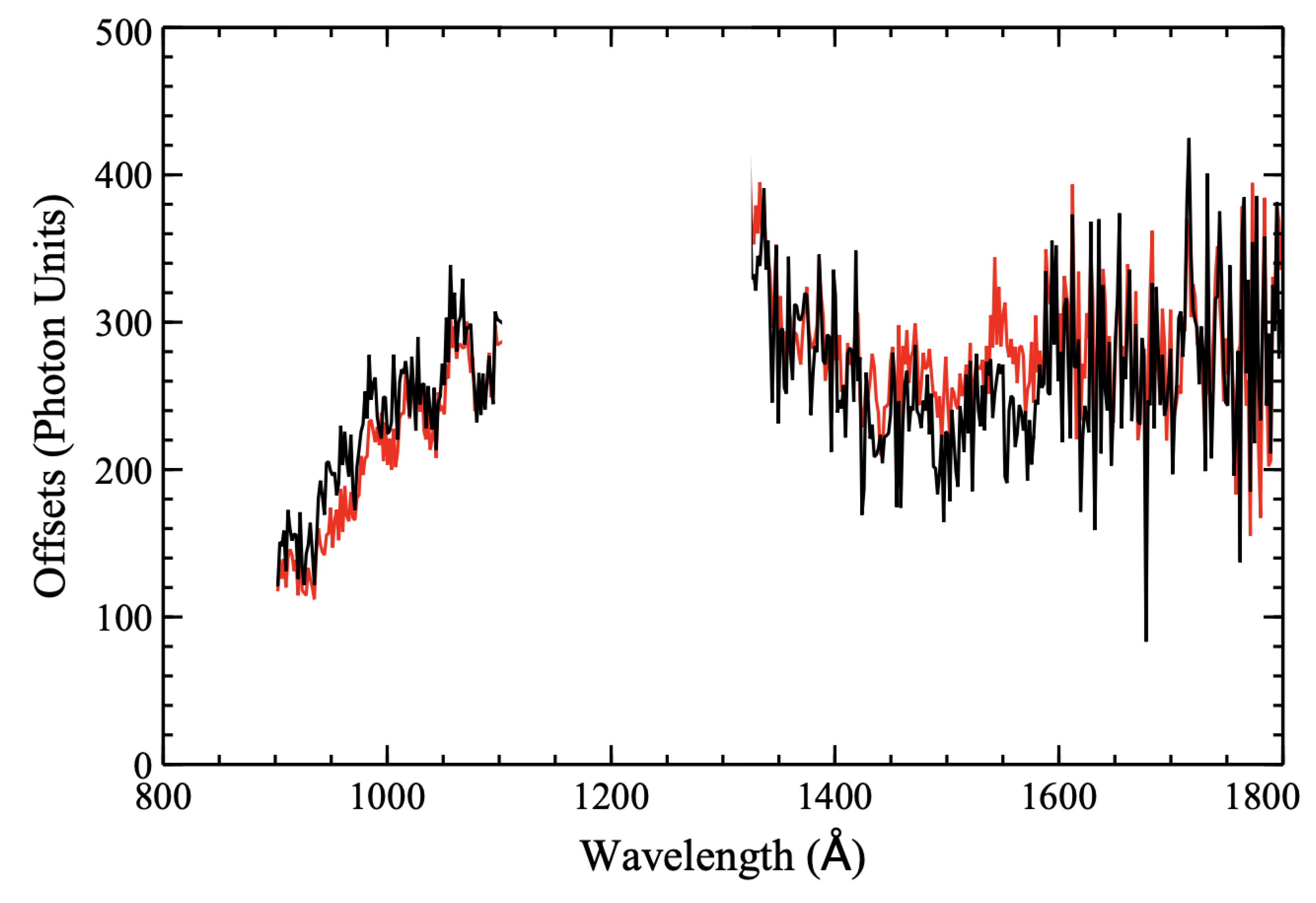
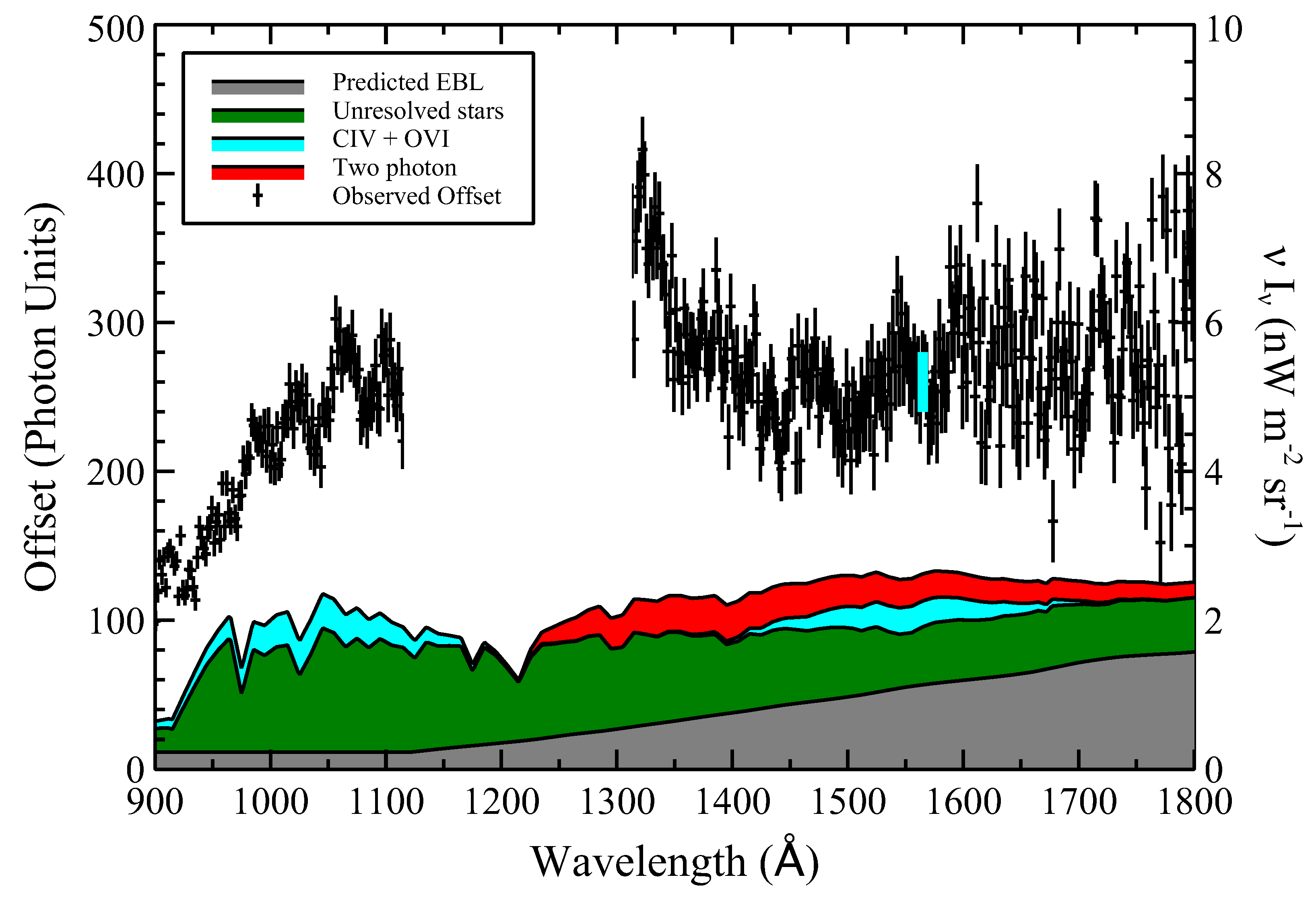
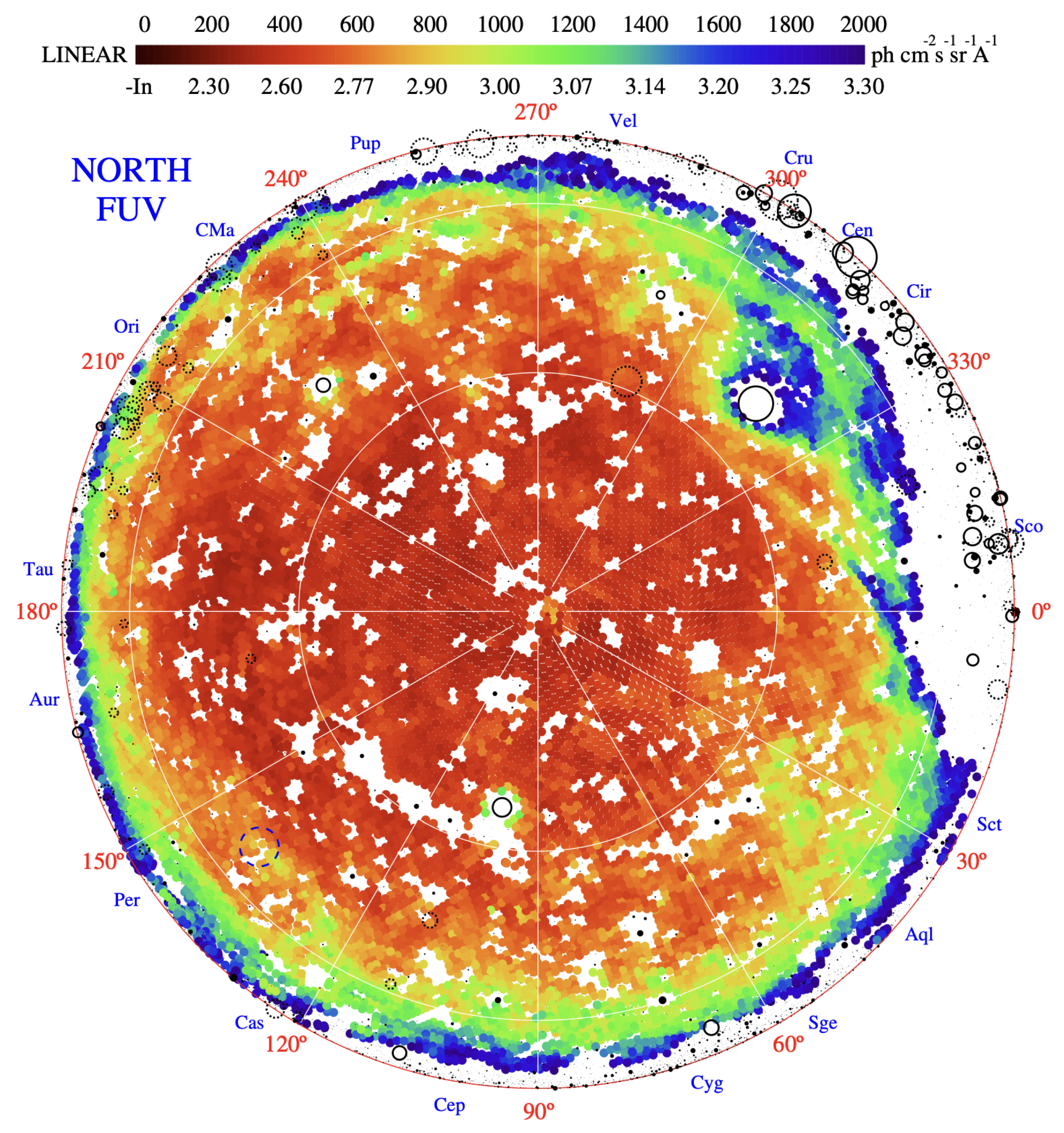

Disclaimer/Publisher’s Note: The statements, opinions and data contained in all publications are solely those of the individual author(s) and contributor(s) and not of MDPI and/or the editor(s). MDPI and/or the editor(s) disclaim responsibility for any injury to people or property resulting from any ideas, methods, instructions or products referred to in the content. |
© 2025 by the authors. Licensee MDPI, Basel, Switzerland. This article is an open access article distributed under the terms and conditions of the Creative Commons Attribution (CC BY) license (https://creativecommons.org/licenses/by/4.0/).
Share and Cite
Henry, R.C.; Murthy, J.; Overduin, J. Ultraviolet Background Radiation from Not-So-Dark Matter in the Galactic Halo. Universe 2025, 11, 148. https://doi.org/10.3390/universe11050148
Henry RC, Murthy J, Overduin J. Ultraviolet Background Radiation from Not-So-Dark Matter in the Galactic Halo. Universe. 2025; 11(5):148. https://doi.org/10.3390/universe11050148
Chicago/Turabian StyleHenry, Richard Conn, Jayant Murthy, and James Overduin. 2025. "Ultraviolet Background Radiation from Not-So-Dark Matter in the Galactic Halo" Universe 11, no. 5: 148. https://doi.org/10.3390/universe11050148
APA StyleHenry, R. C., Murthy, J., & Overduin, J. (2025). Ultraviolet Background Radiation from Not-So-Dark Matter in the Galactic Halo. Universe, 11(5), 148. https://doi.org/10.3390/universe11050148







